HP dv4-2160us User Manual
Notebook PC User Guide
© Copyright 2009 Hewlett-Packard
Development Company, L.P.
ATI and ATI Mobility Radeon are trademarks of Advanced Micro Devices, Inc. Bluetooth is a trademark owned by its proprietor and used by Hewlett-Packard Company under license. Intel is a trademark of Intel Corporation in the U.S. and other countries. Microsoft and Windows are U.S. registered trademarks of Microsoft Corporation. SD Logo is a trademark of its proprietor.
The information contained herein is subject to change without notice. The only warranties for HP products and services are set forth in the express warranty statements accompanying such products and services. Nothing herein should be construed as constituting an additional warranty. HP shall not be liable for technical or editorial errors or omissions contained herein.
First Edition: December 2009
Document Part Number: 590542-001
Product notice
This user guide describes features that are common to most models. Some features may not be available on your computer.

Safety warning notice
WARNING! To reduce the possibility of heat-related injuries or of overheating the computer, do not place the computer directly on your lap or obstruct the computer air vents. Use the computer only on a hard, flat surface. Do not allow another hard surface, such as an adjoining optional printer, or a soft surface, such as pillows or rugs or clothing, to block airflow. Also, do not allow the AC adapter to contact the skin or a soft surface, such as pillows or rugs or clothing, during operation. The computer and the AC adapter comply with the user-accessible surface temperature limits defined by the International Standard for Safety of Information Technology Equipment (IEC 60950).
iii
iv Safety warning notice

Table of contents
1 Using HP QuickWeb (select models only) |
|
Starting HP QuickWeb ......................................................................................................................... |
2 |
Disabling and enabling HP QuickWeb ................................................................................................. |
2 |
2 Features |
|
Identifying hardware ............................................................................................................................. |
3 |
Components ......................................................................................................................................... |
4 |
Top components .................................................................................................................. |
4 |
TouchPad ............................................................................................................ |
4 |
Lights ................................................................................................................... |
5 |
Buttons, speakers, and fingerprint reader ........................................................... |
7 |
Keys .................................................................................................................... |
8 |
Display ................................................................................................................ |
9 |
Front components .............................................................................................................. |
10 |
Rear component ................................................................................................................ |
10 |
Right-side components ...................................................................................................... |
11 |
Left-side components ........................................................................................................ |
12 |
Bottom components ........................................................................................................... |
13 |
Wireless antennas ............................................................................................................. |
14 |
Additional hardware components ...................................................................................... |
15 |
Labels ................................................................................................................................................. |
16 |
3 Wireless, local area network, and modem |
|
Using wireless devices ....................................................................................................................... |
17 |
Identifying wireless and network status icons .................................................................... |
18 |
Using the wireless controls ................................................................................................ |
18 |
Using the wireless button ................................................................................................... |
19 |
Using HP Wireless Assistant ............................................................................................. |
19 |
Using HP Connection Manager (select models only) ........................................................ |
20 |
Using operating system controls ........................................................................................ |
20 |
Using a WLAN .................................................................................................................................... |
21 |
Setting up a WLAN ............................................................................................................ |
21 |
Protecting your WLAN ....................................................................................................... |
22 |
Connecting to a WLAN ...................................................................................................... |
23 |
v
Roaming to another network .............................................................................................. |
23 |
Using HP Mobile Broadband (select models only) ............................................................................. |
24 |
Inserting a SIM ................................................................................................................... |
25 |
Removing a SIM ................................................................................................................ |
26 |
Using Bluetooth wireless devices (select models only) ...................................................................... |
27 |
Bluetooth and Internet Connection Sharing (ICS) ............................................................. |
27 |
Troubleshooting wireless connection problems ................................................................................. |
28 |
Cannot connect to a WLAN ............................................................................................... |
28 |
Cannot connect to a preferred network ............................................................................. |
29 |
Network icon is not displayed ............................................................................................ |
29 |
Current network security codes are unavailable ................................................................ |
29 |
WLAN connection is very weak ......................................................................................... |
30 |
Cannot connect to the wireless router ............................................................................... |
30 |
Using the modem (select models only) .............................................................................................. |
31 |
Connecting a modem cable ............................................................................................... |
31 |
Connecting a country-specific modem cable adapter ........................................................ |
32 |
Selecting a location setting ................................................................................................ |
32 |
Viewing the current location selection ............................................................... |
32 |
Adding new locations when traveling ................................................................ |
33 |
Solving travel connection problems .................................................................. |
34 |
Connecting to a local area network .................................................................................................... |
35 |
4 Pointing devices and keyboard |
|
Using the TouchPad ........................................................................................................................... |
36 |
Setting TouchPad preferences .......................................................................................... |
37 |
Connecting an external mouse .......................................................................................... |
37 |
Using keyboard hotkeys ..................................................................................................................... |
38 |
Displaying system information ........................................................................................... |
39 |
Opening Help and Support ................................................................................................ |
39 |
Opening the Print Options window .................................................................................... |
40 |
Opening a Web browser .................................................................................................... |
40 |
Switching the screen image ............................................................................................... |
40 |
Initiating Sleep ................................................................................................................... |
41 |
Initiating QuickLock ........................................................................................................... |
41 |
Decreasing screen brightness ........................................................................................... |
41 |
Increasing screen brightness ............................................................................................. |
41 |
Playing, pausing or resuming an audio CD or a DVD ....................................................... |
42 |
Stopping an audio CD or a DVD ........................................................................................ |
42 |
Playing previous track or section of an audio CD or a DVD .............................................. |
42 |
Playing next track or section of an audio CD or a DVD .................................................... |
42 |
Using keypads .................................................................................................................................... |
43 |
Using the embedded numeric keypad ............................................................................... |
44 |
Enabling and disabling the embedded numeric keypad .................................... |
44 |
vi
Switching key functions on the embedded numeric keypad ............................. |
44 |
Using an optional external numeric keypad ....................................................................... |
44 |
Cleaning the TouchPad and keyboard ............................................................................................... |
45 |
5 Multimedia |
|
Multimedia features ............................................................................................................................ |
46 |
Identifying your multimedia components ........................................................................... |
47 |
Using the MediaSmart button (select models only) ........................................................... |
48 |
Adjusting the volume ......................................................................................................... |
49 |
Using the media activity hotkeys ....................................................................................... |
50 |
Multimedia software ........................................................................................................................... |
51 |
Using HP MediaSmart software ......................................................................................... |
51 |
Using other preinstalled multimedia software .................................................................... |
51 |
Installing multimedia software from a disc ......................................................................... |
51 |
Audio .................................................................................................................................................. |
52 |
Connecting external audio devices .................................................................................... |
52 |
Checking your audio functions ........................................................................................... |
52 |
Video .................................................................................................................................................. |
53 |
Connecting an external monitor or projector ...................................................................... |
53 |
Connecting an HDMI device .............................................................................................. |
54 |
Configuring audio for HDMI ............................................................................................... |
55 |
Watching TV (select models only) ..................................................................................... |
56 |
Webcam ............................................................................................................................................. |
57 |
Troubleshooting .................................................................................................................................. |
58 |
The optical disc tray does not open for removal of a CD, DVD, or BD .............................. |
58 |
The computer does not detect the optical drive ................................................................. |
59 |
A disc does not play ........................................................................................................... |
60 |
A disc does not play automatically ..................................................................................... |
60 |
A DVD movie stops, skips, or plays erratically .................................................................. |
61 |
A DVD movie is not visible on an external display ............................................................. |
61 |
The process of burning a disc does not begin, or it stops before completion .................... |
61 |
A DVD playing in Windows Media Player produces no sound or display .......................... |
62 |
A device driver must be reinstalled .................................................................................... |
62 |
Obtaining the latest HP device drivers .............................................................. |
63 |
Obtaining the latest Windows device drivers .................................................... |
63 |
6 HP Mobile Remote Control (Select Models Only) |
|
Component functions ......................................................................................................................... |
64 |
Button quick reference ....................................................................................................................... |
65 |
Inserting or replacing the battery ........................................................................................................ |
68 |
Troubleshooting .................................................................................................................................. |
69 |
vii
7 HP Media Remote Control (Select Models Only) |
|
Component functions ......................................................................................................................... |
70 |
Button quick reference ....................................................................................................................... |
71 |
Inserting or replacing the battery ........................................................................................................ |
75 |
Troubleshooting .................................................................................................................................. |
76 |
8 Power management |
|
Setting power options ......................................................................................................................... |
77 |
Using power-saving states ................................................................................................. |
77 |
Initiating and exiting Sleep ................................................................................ |
77 |
Initiating and exiting Hibernation ....................................................................... |
78 |
Using the battery meter ..................................................................................................... |
78 |
Using power plans ............................................................................................................. |
79 |
Viewing the current power plan ......................................................................... |
79 |
Selecting a different power plan ........................................................................ |
79 |
Customizing power plans .................................................................................. |
79 |
Setting password protection on wakeup ............................................................................ |
79 |
Switching between graphics modes (select models only) .................................................................. |
80 |
Using external AC power .................................................................................................................... |
81 |
Connecting the AC adapter ............................................................................................... |
82 |
Testing an AC adapter ....................................................................................................... |
83 |
Using battery power ........................................................................................................................... |
84 |
Finding battery information in Help and Support ............................................................... |
84 |
Using Battery Check .......................................................................................................... |
84 |
Displaying the remaining battery charge ........................................................................... |
85 |
Inserting or removing the battery ....................................................................................... |
85 |
Charging a battery ............................................................................................................. |
86 |
Maximizing battery discharge time .................................................................................... |
87 |
Managing low battery levels .............................................................................................. |
87 |
Identifying low battery levels ............................................................................. |
87 |
Resolving a low battery level ............................................................................. |
88 |
Resolving a low battery level when external power is available ....... |
88 |
Resolving a low battery level when a charged battery is |
|
available ........................................................................................... |
88 |
Resolving a low battery level when no power source is |
|
available ........................................................................................... |
88 |
Resolving a low battery level when the computer cannot exit |
|
Hibernation ....................................................................................... |
88 |
Calibrating a battery ........................................................................................................... |
89 |
Step 1: Fully charge the battery ........................................................................ |
89 |
Step 2: Disable Hibernation and Sleep ............................................................. |
89 |
Step 3: Discharge the battery ............................................................................ |
90 |
Step 4: Fully recharge the battery ..................................................................... |
90 |
Step 5: Reenable Hibernation and Sleep .......................................................... |
90 |
viii
Conserving battery power .................................................................................................. |
91 |
Storing a battery ................................................................................................................ |
91 |
Disposing of a used battery ............................................................................................... |
91 |
Replacing the battery ......................................................................................................... |
91 |
Shutting down the computer ............................................................................................................... |
92 |
9 Drives |
|
Handling drives ................................................................................................................................... |
93 |
Optical drive ....................................................................................................................................... |
94 |
Identifying the installed optical drive .................................................................................. |
94 |
Using optical discs ............................................................................................................. |
95 |
Selecting the right disc ....................................................................................................... |
96 |
CD-R discs ........................................................................................................ |
96 |
CD-RW discs ..................................................................................................... |
96 |
DVD±R discs ..................................................................................................... |
96 |
DVD±RW discs ................................................................................................. |
96 |
LightScribe DVD+R discs .................................................................................. |
97 |
Blu-ray Disc ....................................................................................................... |
97 |
Playing a CD, DVD, or BD ................................................................................................. |
97 |
Configuring AutoPlay ......................................................................................................... |
98 |
Changing DVD region settings .......................................................................................... |
98 |
Observing the copyright warning ....................................................................................... |
99 |
Copying a CD or DVD ........................................................................................................ |
99 |
Creating (burning) a CD or DVD ...................................................................................... |
100 |
Removing an optical disc (CD, DVD, or BD) ................................................................... |
101 |
Using external drives ........................................................................................................................ |
102 |
Improving hard drive performance ................................................................................................... |
103 |
Using Disk Defragmenter ................................................................................................. |
103 |
Using Disk Cleanup ......................................................................................................... |
103 |
Using HP ProtectSmart Hard Drive Protection (select models only) ................................................ |
104 |
Identifying HP ProtectSmart Hard Drive Protection status .............................................. |
104 |
Using HP ProtectSmart Hard Drive Protection software .................................................. |
105 |
Replacing the hard drive .................................................................................................................. |
106 |
Replacing a drive in the SmartBay ................................................................................................... |
110 |
10 External devices |
|
Using a USB device ......................................................................................................................... |
112 |
Connecting a USB device ................................................................................................ |
112 |
Removing a USB device .................................................................................................. |
113 |
Using an eSATA device ................................................................................................................... |
114 |
Connecting an eSATA device .......................................................................................... |
114 |
Removing an eSATA device ............................................................................................ |
115 |
Using the expansion port .................................................................................................................. |
115 |
ix
11 External media cards |
|
Using Digital Media Slot cards ......................................................................................................... |
116 |
Inserting a digital card ...................................................................................................... |
116 |
Removing a digital card ................................................................................................... |
117 |
Using ExpressCards ......................................................................................................................... |
118 |
Configuring an ExpressCard ............................................................................................ |
118 |
Inserting an ExpressCard ................................................................................................ |
118 |
Removing an ExpressCard .............................................................................................. |
120 |
12 Memory modules |
|
13 Security |
|
Protecting the computer ................................................................................................................... |
125 |
Using passwords .............................................................................................................................. |
126 |
Setting passwords in Windows ........................................................................................ |
126 |
Setting passwords in Setup Utility ................................................................................... |
127 |
Administrator password ................................................................................... |
127 |
Managing an administrator password ............................................. |
127 |
Entering an administrator password ............................................... |
128 |
Power-on password ........................................................................................ |
128 |
Managing a power-on password .................................................... |
128 |
Entering a power-on password ....................................................... |
128 |
Using antivirus software ................................................................................................................... |
129 |
Using firewall software ..................................................................................................................... |
129 |
Installing critical security updates ..................................................................................................... |
130 |
Installing an optional security cable .................................................................................................. |
130 |
Using the fingerprint reader (select models only) ............................................................................. |
131 |
Locating the fingerprint reader ......................................................................................... |
131 |
Registering fingerprints .................................................................................................... |
132 |
Using your registered fingerprint to log on to Windows ................................................... |
133 |
Appendix A Setup Utility (BIOS) |
|
Starting Setup Utility ......................................................................................................................... |
134 |
Using Setup Utility ............................................................................................................................ |
135 |
Changing the language of Setup Utility ........................................................................... |
135 |
Navigating and selecting in Setup Utility .......................................................................... |
135 |
Displaying system information ......................................................................................... |
136 |
Restoring default settings in Setup Utility ........................................................................ |
136 |
Exiting Setup Utility .......................................................................................................... |
137 |
Setup Utility menus .......................................................................................................................... |
137 |
Main menu ....................................................................................................................... |
137 |
Security menu .................................................................................................................. |
137 |
System Configuration menu ............................................................................................ |
138 |
x
Diagnostics menu ............................................................................................................ |
138 |
Appendix B Software updates |
|
Updating the BIOS ........................................................................................................................... |
140 |
Determining the BIOS version ......................................................................................... |
140 |
Downloading a BIOS update ........................................................................................... |
141 |
Updating programs and drivers ........................................................................................................ |
142 |
Appendix C Backup and recovery |
|
Creating recovery discs .................................................................................................................... |
144 |
Backing up your information ............................................................................................................. |
145 |
Using Windows Backup and Restore .............................................................................. |
146 |
Using system restore points ............................................................................................ |
147 |
When to create restore points ......................................................................... |
147 |
Create a system restore point ......................................................................... |
147 |
Restore to a previous date and time ............................................................... |
147 |
Performing a recovery ...................................................................................................................... |
148 |
Recovering from the recovery discs ................................................................................ |
148 |
Recovering from the dedicated recovery partition (select models only) .......................... |
148 |
Index ................................................................................................................................................................. |
149 |
xi
xii

1Using HP QuickWeb (select models only)
Your computer's main operating system is Windows®. Your computer may also feature HP QuickWeb (select models only).
●The Microsoft® Windows operating system displays the desktop on the display and controls your computer's hardware, peripherals, and software programs.
●If your computer includes HP QuickWeb, it allows you to quickly browse the Internet, view digital photos, listen to music, or keep in touch using e-mail, instant messages, or Skype (select models only), without having to start your main operating system. HP QuickWeb is also referred to as Instant-On Software (IOS).
 NOTE: You can access the software Help when you are in HP QuickWeb by clicking the Help icon in the notification area.
NOTE: You can access the software Help when you are in HP QuickWeb by clicking the Help icon in the notification area.
1

Starting HP QuickWeb
To start HP QuickWeb:
1.Turn on your computer. The HP QuickWeb screen opens.
2.Click an icon on the HP QuickWeb screen to start a program. To start HP QuickWeb from Microsoft Windows:
▲Select Start, click the arrow next to the Shut down button, and then click Restart. Your computer restarts and displays the HP QuickWeb home page.
 NOTE: To learn more about HP QuickWeb, refer to the HP QuickWeb software Help.
NOTE: To learn more about HP QuickWeb, refer to the HP QuickWeb software Help.
Disabling and enabling HP QuickWeb
To disable or reenable HP QuickWeb from within the Windows operating system:
1.Click Start, click All Programs, and then click HP QuickWeb. The HP QuickWeb Installer folder displays. Click HP QuickWeb Configuration Tool.
2.Select the Enable HP QuickWeb check box.
3.Click OK.
 NOTE: The HP QuickWeb Configuration Tool can also be accessed by clicking Start, clicking Control Panel, and then clicking the View by arrow. Select Large icons or Small icons to locate the HP QuickWeb Configuration Tool.
NOTE: The HP QuickWeb Configuration Tool can also be accessed by clicking Start, clicking Control Panel, and then clicking the View by arrow. Select Large icons or Small icons to locate the HP QuickWeb Configuration Tool.
2 |
Chapter 1 Using HP QuickWeb (select models only) |

2 Features
Identifying hardware
To see a list of hardware installed in the computer, follow these steps:
▲Select Start > Control Panel > System and Security. Then in the System area, click Device Manager.
You can also add hardware or modify device configurations using Device Manager.
 NOTE: Windows® includes the User Account Control feature to improve the security of your computer. You may be prompted for your permission or password for tasks such as installing software, running utilities, or changing Windows settings. Refer to Help and Support for more information.
NOTE: Windows® includes the User Account Control feature to improve the security of your computer. You may be prompted for your permission or password for tasks such as installing software, running utilities, or changing Windows settings. Refer to Help and Support for more information.
Identifying hardware |
3 |
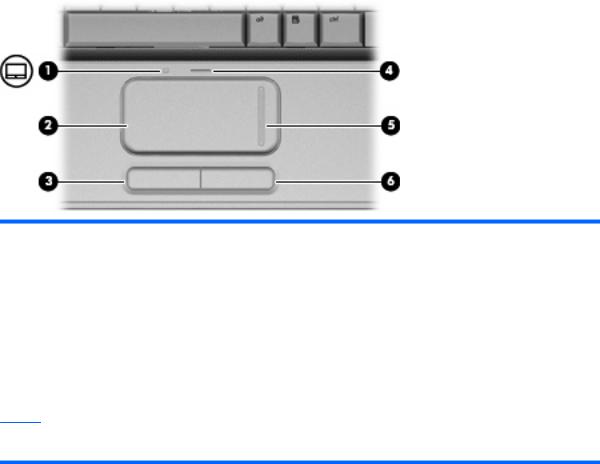
Components
Top components
TouchPad
Component |
Description |
|
|
|
|
(1) |
TouchPad light |
● White: TouchPad is enabled. |
|
|
● Amber: TouchPad is disabled. |
|
|
|
(2) |
TouchPad* |
Moves the pointer and selects or activates items on the screen. |
|
|
|
(3) |
Left TouchPad button* |
Functions like the left button on an external mouse. |
|
|
|
(4) |
TouchPad on/off button |
Enables/disables the TouchPad. |
|
|
|
(5) |
TouchPad vertical scroll zone |
Scrolls up or down. |
|
|
|
(6) |
Right TouchPad button* |
Functions like the right button on an external mouse. |
*This table describes factory settings. To view or change TouchPad preferences, select Start > Devices and Printers. Then, right-click the device representing your computer, and select Mouse settings.
4 Chapter 2 Features
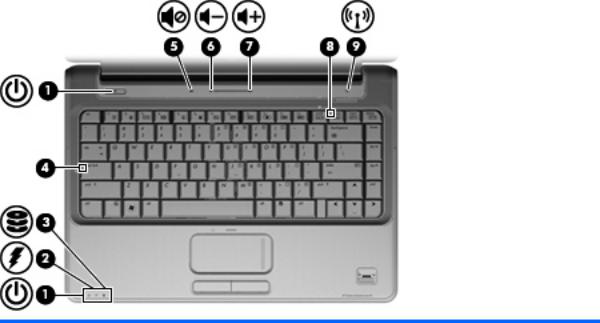
Lights
Component |
Description |
|
|
|
|
(1) |
Power lights (2)* |
● On: The computer is on. |
|
|
● Blinking: The computer is in the Sleep state. |
|
|
● Off: The computer is off or in Hibernation. |
|
|
|
(2) |
Battery light |
● On: A battery is charging. |
|
|
● Blinking: A battery that is the only available power source has |
|
|
reached a low battery level or a critical battery level. |
|
|
● Off: If the computer is plugged into an external power source, |
|
|
the light is turned off when all batteries in the computer are |
|
|
fully charged. If the computer is not plugged into an external |
|
|
power source, the light stays off until the battery reaches a |
|
|
low battery level. |
|
|
|
(3) |
Drive light |
● Blinking: The hard drive or optical drive is being accessed. |
|
|
● On: HP ProtectSmart Hard Drive Protection has temporarily |
|
|
parked the internal hard drive, and if present, the hard drive |
|
|
in the SmartBay. |
|
|
|
(4) |
Caps lock light |
On: Caps lock is on. |
|
|
|
(5) |
Volume mute light |
● White: Computer sound is turned on. |
|
|
● Amber: Computer sound is turned off. |
|
|
|
(6) |
Volume down light |
On: The volume scroll zone is being used to decrease speaker |
|
|
volume. |
|
|
|
(7) |
Volume up light |
On: The volume scroll zone is being used to increase speaker |
|
|
volume. |
|
|
|
Components 5

Component |
Description |
|
|
|
|
(8) |
Num lock light |
On: The embedded numeric keypad is enabled. |
|
|
– or – |
|
|
Num lock is enabled on a connected optional numeric keypad. |
|
|
|
(9) |
Wireless light |
● Blue: An integrated wireless device, such as a wireless local |
|
|
area network (WLAN) device and/or a Bluetooth® device, is |
|
|
on. |
● Amber: All wireless devices are off.
*The 2 power lights display the same information. The light on the power button is visible only when the computer is open. The power light on the front of the computer is visible whether the computer is open or closed.
6 Chapter 2 Features
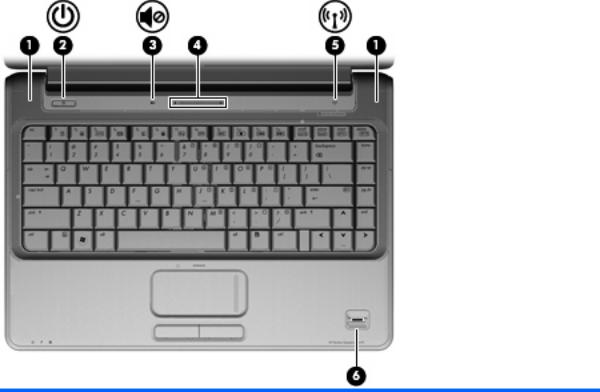
Buttons, speakers, and fingerprint reader
Component |
Description |
|
|
|
|
(1) |
Speakers (2) |
Produce sound. |
|
|
|
(2) |
Power button* |
● When the computer is off, press the button to turn on the |
|
|
computer. |
|
|
● When the computer is on, briefly press the button to initiate |
|
|
Sleep. |
|
|
● When the computer is in the Sleep state, briefly press the |
|
|
button to exit Sleep. |
|
|
● When the computer is in Hibernation, briefly press the button |
|
|
to exit Hibernation. |
|
|
If the computer has stopped responding and Windows® shutdown |
|
|
procedures are ineffective, press and hold the power button for at |
|
|
least 5 seconds to turn off the computer. |
|
|
To learn more about your power settings, select Start > Control |
|
|
Panel > System and Security > Power Options. |
|
|
|
(3) |
Volume mute button |
Mutes and restores speaker sound. |
|
|
|
(4) |
Volume scroll zone |
Adjusts speaker volume. Slide your finger to the left to decrease |
|
|
volume and to the right to increase volume. You can also tap the |
|
|
minus sign on the scroll zone to decrease volume, or tap the plus |
|
|
sign on the scroll zone to increase volume. |
|
|
|
Components 7
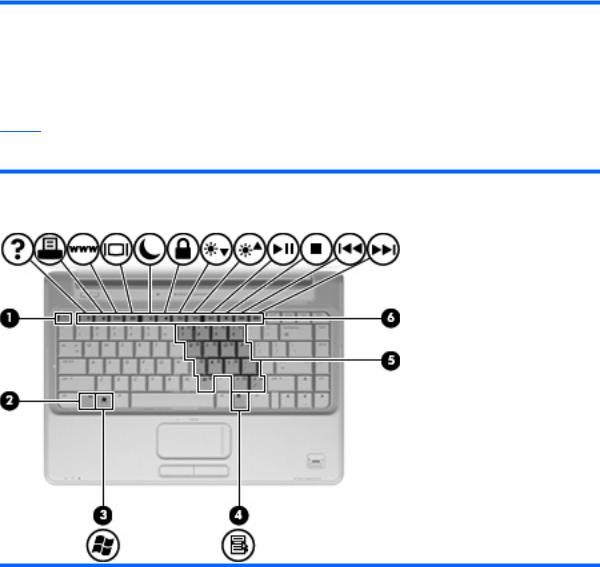
Component |
Description |
|
|
|
|
(5) |
Wireless button |
Turns the wireless feature on or off but does not establish a |
|
|
wireless connection. |
|
|
NOTE: A wireless network must be set up in order to establish a |
|
|
wireless connection. |
|
|
|
(6) |
Fingerprint reader (select models only) |
Allows a fingerprint logon to Windows, instead of a password logon. |
*This table describes factory settings. For information about changing factory settings, refer to the user guides located in Help and Support.
Keys
Component |
Description |
|
|
|
|
(1) |
esc key |
Displays system information when pressed in combination with the |
|
|
fn key. |
|
|
|
(2) |
fn key |
Executes frequently used system functions when pressed in |
|
|
combination with a function key or the esc key. |
|
|
|
(3) |
Windows logo key |
Displays the Windows Start menu. |
|
|
|
(4) |
Windows applications key |
Displays a shortcut menu for items beneath the pointer. |
|
|
|
(5) |
Embedded numeric keypad keys |
Can be used like the keys on an external numeric keypad. |
|
|
|
(6) |
Function keys |
Execute frequently used system functions when pressed in |
|
|
combination with the fn key. |
|
|
|
8 Chapter 2 Features
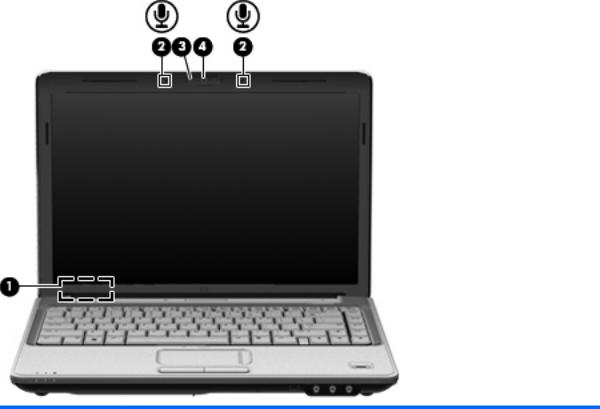
Display
Component |
Description |
|
|
|
|
(1) |
Internal display switch |
Turns off the display if the display is closed while the computer is |
|
|
turned on. |
|
|
|
(2) |
Internal digital dual-array microphones (2) |
Record sound. |
|
|
|
(3) |
Integrated webcam light |
On: The integrated webcam is in use. |
|
|
|
(4) |
Integrated webcam |
Records video and captures still photographs. |
|
|
|
Components 9
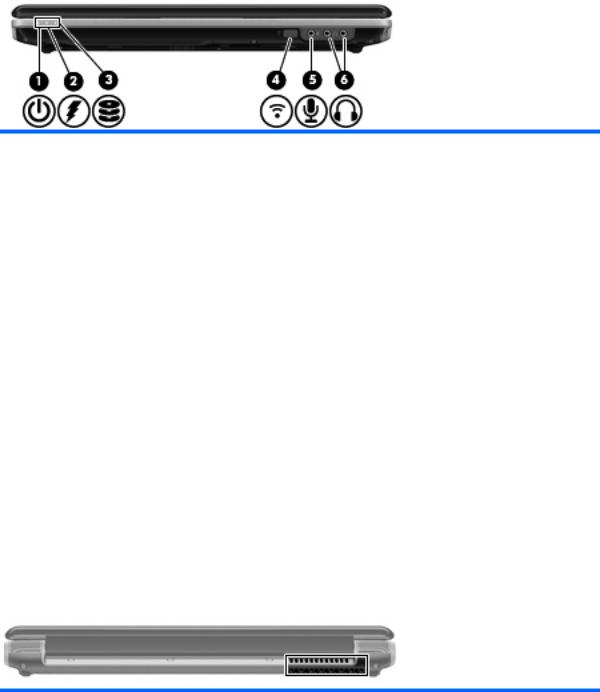
Front components
Component |
Description |
||
|
|
|
|
(1) |
Power light |
● |
On: The computer is on. |
|
|
● |
Blinking: The computer is in the Sleep state. |
|
|
● |
Off: The computer is off or in Hibernation. |
|
|
|
|
(2) |
Battery light |
● |
On: A battery is charging. |
|
|
● |
Blinking: A battery that is the only available power source has |
|
|
|
reached a low battery level or a critical battery level. |
|
|
● |
Off: If the computer is plugged into an external power source, |
|
|
|
the light is turned off when all batteries in the computer are |
|
|
|
fully charged. If the computer is not plugged into an external |
|
|
|
power source, the light stays off until the battery reaches a low |
|
|
|
battery level. |
|
|
|
|
(3) |
Drive light |
● |
Blinking: The hard drive or optical drive is being accessed. |
|
|
● |
On: HP ProtectSmart Hard Drive Protection has temporarily |
|
|
|
parked the internal hard drive, and if present, the hard drive |
|
|
|
in the SmartBay. |
|
|
|
|
(4) |
Consumer infrared lens |
Receives a signal from the HP Remote Control. |
|
|
|
|
|
(5) |
Audio-in (microphone) jack |
Connects an optional computer headset microphone, stereo array |
|
|
|
microphone, or monaural microphone. |
|
|
|
|
|
(6) |
Audio-out (headphone) jacks (2) |
Produce sound when connected to optional powered stereo |
|
|
|
speakers, headphones, earbuds, a headset, or television audio. |
|
|
|
|
|
Rear component
Component |
Description |
|
|
Vent |
Enables airflow to cool internal components. |
|
NOTE: The computer fan starts up automatically to cool internal |
|
components and prevent overheating. It is normal for the internal fan to |
|
cycle on and off during routine operation. |
|
|
10 Chapter 2 Features

Right-side components
Component |
Description |
|
|
|
|
(1) |
SmartBay |
Supports an optical drive or hard drive. |
|
|
|
(2) |
USB ports (2) |
Connect optional USB devices. |
|
|
|
(3) |
TV antenna/cable jack (select models only) |
Connects a TV antenna, a digital cable device, or a satellite device |
|
|
that receives standard or high-definition TV broadcasts. |
|
|
|
(4) |
RJ-11 (modem) jack (select models only) |
Connects a modem cable. |
|
|
|
(5) |
Power connector |
Connects an AC adapter. |
|
|
|
Components 11

Left-side components
Component |
Description |
||
|
|
|
|
(1) |
Security cable slot |
Attaches an optional security cable to the computer. |
|
|
|
NOTE: The security cable is designed to act as a deterrent, but |
|
|
|
it may not prevent the computer from being mishandled or stolen. |
|
|
|
|
|
(2) |
External monitor port |
Connects an external VGA monitor or projector. |
|
|
|
|
|
(3) |
Expansion port 3 |
Connects the computer to an optional docking device or optional |
|
|
|
expansion product. |
|
|
|
NOTE: The computer has only one expansion port. The term |
|
|
|
expansion port 3 describes the type of expansion port. |
|
|
|
|
|
(4) |
RJ-45 (network) jack |
Connects a network cable. |
|
|
|
|
|
(5) |
HDMI port |
Connects an optional video or audio device, such as a high- |
|
|
|
definition television, or any compatible digital or audio component. |
|
|
|
|
|
(6) |
eSATA/USB port |
Connects a high-performance eSATA component, such as an |
|
|
|
eSATA external hard drive, or connects an optional USB device. |
|
|
|
|
|
(7) |
Digital Media Slot light |
On: A digital card is being accessed. |
|
|
|
|
|
(8) |
Digital Media Slot |
Supports the following optional digital card formats: |
|
|
|
● |
Memory Stick (MS) |
|
|
● Memory Stick Pro (MSP) |
|
|
|
● |
MultiMediaCard (MMC) |
|
|
● Secure Digital (SD) Memory Card |
|
|
|
● xD-Picture Card (XD) |
|
|
|
|
|
(9) |
ExpressCard slot |
Supports optional ExpressCard/54 cards. |
|
|
|
|
|
12 Chapter 2 Features

Bottom components
Component |
Description |
|
|
|
|
(1) |
Hard drive bay |
Holds the hard drive and the wireless LAN (WLAN) module. |
|
|
CAUTION: To prevent an unresponsive system, replace the |
|
|
wireless module only with a wireless module authorized for use in |
|
|
the computer by the governmental agency that regulates wireless |
|
|
devices in your country or region. If you replace the module and |
|
|
then receive a warning message, remove the module to restore |
|
|
computer functionality, and then contact technical support through |
|
|
Help and Support. |
|
|
|
(2) |
SmartBay release latch |
Releases the SmartBay module. |
|
|
|
(3) |
Memory module compartment |
Contains the 2 memory module slots. |
|
|
|
(4) |
Mini Card compartment |
Holds the RTC battery and, on select models, holds a |
|
|
wireless WAN (WWAN) module or a TV tuner card. |
|
|
CAUTION: To prevent an unresponsive system, replace the |
|
|
wireless module only with a wireless module authorized for use in |
|
|
the computer by the governmental agency that regulates wireless |
|
|
devices in your country or region. If you replace the module and |
|
|
then receive a warning message, remove the module to restore |
|
|
computer functionality, and then contact technical support through |
|
|
Help and Support. |
|
|
|
(5) |
Battery release latch |
Releases the battery from the battery bay. |
|
|
|
(6) |
SIM slot (select models only) |
Contains a subscriber identity module (SIM). The SIM slot is |
|
|
located inside the battery bay. |
|
|
|
(7) |
Battery bay |
Holds the battery. |
|
|
|
(8) |
Vents (3) |
Enable airflow to cool internal components. |
|
|
NOTE: The computer fan starts up automatically to cool internal |
|
|
components and prevent overheating. It is normal for the internal |
|
|
fan to cycle on and off during routine operation. |
|
|
|
Components 13
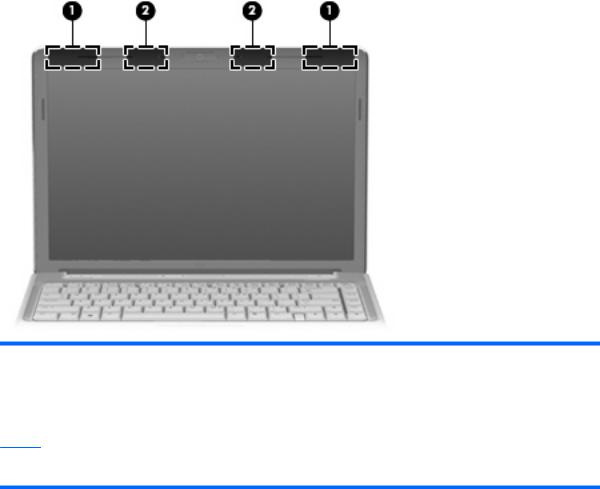
Wireless antennas
Component |
Description |
|
|
|
|
(1) |
WWAN antennas (2)* (select models only) |
Send and receive wireless signals to communicate with wireless |
|
|
wide-area networks (WWAN). |
|
|
|
(2) |
WLAN antennas (2)* |
Send and receive wireless signals to communicate with wireless |
|
|
local area networks (WLAN). |
*The antennas are not visible from the outside of the computer. For optimal transmission, keep the areas immediately around the antennas free from obstructions.
To see wireless regulatory notices, refer to the section of the Regulatory, Safety and Environmental Notices that applies to your country or region. These notices are located in Help and Support.
14 Chapter 2 Features
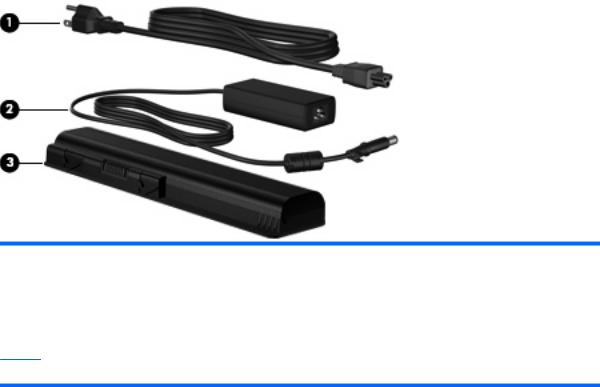
Additional hardware components
Component |
Description |
|
|
|
|
(1) |
Power cord* |
Connects an AC adapter to an AC outlet. |
|
|
|
(2) |
AC adapter |
Converts AC power to DC power. |
|
|
|
(3) |
Battery* |
Powers the computer when the computer is not plugged into |
|
|
external power. |
*Batteries and power cords vary in appearance by country or region.
Components 15

Labels
The labels affixed to the computer provide information you may need when you troubleshoot system problems or travel internationally with the computer.
●Service tag—Provides important information, including the following:
◦Product name (1). This is the product name affixed to the front of your notebook.
◦Serial number (s/n) (2). This is an alphanumeric identifier that is unique to each product.
◦Part number/Product number (p/n) (3). This number provides specific information about the product's hardware components. The part number helps a service technician to determine what components and parts are needed.
◦Model description (4). This is the alphanumeric identifier used to locate documents, drivers, and support for your notebook.
◦Warranty period (5). This number describes the duration of the warranty period for this computer.
Have this information available when you contact technical support. The service tag label is affixed to the bottom of the computer.
●Microsoft® Certificate of Authenticity—Contains the Windows® Product Key. You may need the Product Key to update or troubleshoot the operating system. This certificate is affixed to the bottom of the computer.
●Regulatory label—Provides regulatory information about the computer. The regulatory label is affixed inside the battery bay.
●Modem approval label (select models only)—Provides regulatory information about the modem and lists the agency approval markings required by some of the countries or regions in which the modem has been approved for use. You may need this information when traveling internationally. The modem approval label is affixed inside the hard drive bay.
●Wireless certification label(s)—Provide information about optional wireless devices and the approval markings of some of the countries or regions in which the devices have been approved for use. An optional device may be a wireless local area network (WLAN) device or an optional Bluetooth® device. If your computer model includes one or more wireless devices, one or more certification labels are included with your computer. You may need this information when traveling internationally. Wireless certification labels are affixed inside the Mini Card compartment.
●SIM (subscriber identity module) label (select models only)—Provides the ICCID (Integrated Circuit Card Identifier) of your SIM. This label is located inside the battery bay.
●HP Mobile Broadband Module serial number label (select models only)—Provides the serial number of your HP Mobile Broadband Module. This label is located inside the battery bay.
16 Chapter 2 Features

3Wireless, local area network, and modem
Using wireless devices
Wireless technology transfers data across radio waves instead of wires. Your computer may be equipped with one or more of the following wireless devices:
●Wireless local area network (WLAN) device—Connects the computer to wireless local area networks (commonly referred to as Wi-Fi networks, wireless LANs, or WLANs) in corporate offices, your home, and public places such as airports, restaurants, coffee shops, hotels, and universities. In a WLAN, each mobile wireless device communicates with a wireless router or a wireless access point.
●HP Mobile Broadband Module (select models only)—A wireless wide area network (WWAN) device that provides access to information wherever mobile network operator service is available. In a WWAN, each mobile device communicates to a mobile network operator’s base station. Mobile network operators install networks of base stations (similar to cell phone towers) throughout large geographic areas, effectively providing coverage across entire states, regions, or even countries.
●Bluetooth® device (select models only)—Creates a personal area network (PAN) to connect to other Bluetooth-enabled devices such as computers, phones, printers, headsets, speakers, and cameras. In a PAN, each device communicates directly with other devices, and devices must be relatively close together—typically within 10 meters (approximately 33 feet) of each other.
Computers with WLAN devices support one or more of the following IEEE industry standards:
●802.11b, the first popular standard, supports data rates of up to 11 Mbps and operates at a frequency of 2.4 GHz.
●802.11g supports data rates of up to 54 Mbps and operates at a frequency of 2.4 GHz. An 802.11g WLAN device is backward compatible with 802.11b devices, so they can operate on the same network.
●802.11a supports data rates of up to 54 Mbps and operates at a frequency of 5 GHz.
 NOTE: 802.11a is not compatible with 802.11b and 802.11g.
NOTE: 802.11a is not compatible with 802.11b and 802.11g.
●802.11n supports data rates of up to 450 Mbps and may operate at 2.4 GHz or 5 GHz, making it backward compatible with 802.11a, b, and g.
For more information on wireless technology, refer to the information and Web site links provided in Help and Support.
Using wireless devices 17

Identifying wireless and network status icons
Icon |
Name |
Description |
|
|
|
|
Wireless (connected) |
Identifies the location of the wireless lights and the wireless buttons |
|
|
on the computer. Also identifies the HP Wireless Assistant software |
|
|
on the computer and indicates that one or more of the wireless |
|
|
devices are on. |
|
|
|
|
Wireless (disconnected) |
Identifies the HP Wireless Assistant software on the computer and |
|
|
indicates that all of the wireless devices are off. |
|
|
|
|
HP Connection Manager |
Opens HP Connection Manager, which enables you to create a |
|
|
connection with an HP Mobile Broadband device (select models |
|
|
only). |
|
|
|
|
Wired network (connected) |
Indicates that one or more network drivers are installed, and one or |
|
|
more network devices are connected to a wired network. |
|
|
|
|
Wired network (disabled/ |
Indicates that one or more network drivers are installed, but no |
|
disconnected) |
network devices are connected (or all network devices are disabled |
|
|
in Windows® Control Panel). |
|
|
|
|
Network (connected) |
Indicates that one or more network drivers are installed, and one or |
|
|
more network devices are connected to a wireless network. |
|
|
|
|
Network (disconnected) |
Indicates that one or more network drivers are installed and wireless |
|
|
connections are available, but no network devices are connected to |
|
|
a wireless network. |
|
|
|
|
Network (disabled/ |
Indicates that one or more network drivers are installed, but no |
|
disconnected) |
wireless connections are available (or all wireless network devices |
|
|
are disabled by the wireless button or HP Wireless Assistant). |
|
|
|
Using the wireless controls
You can control the wireless devices in your computer using these features:
●Wireless button or wireless switch (referred to in this guide as the wireless button)
●HP Wireless Assistant software
●HP Connection Manager software (select models only)
●Operating system controls
18 Chapter 3 Wireless, local area network, and modem
